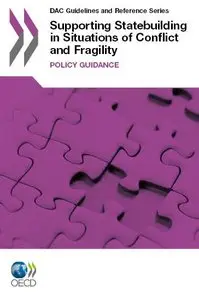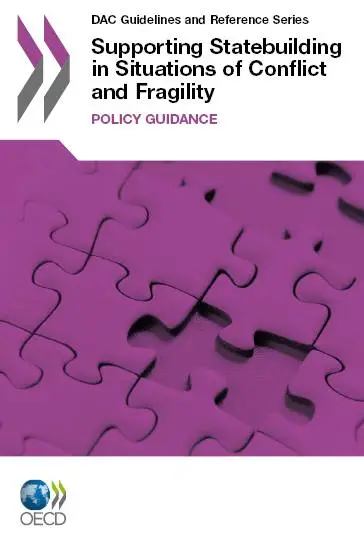Supporting Statebuilding in Situations of Conflict and Fragility: Policy Guidance
DAC Guidelines and Reference Series
OECD | 08 Feb 2011 | ISBN: 9264074965 | 107 pages | PDF | 1 MB
DAC Guidelines and Reference Series
OECD | 08 Feb 2011 | ISBN: 9264074965 | 107 pages | PDF | 1 MB
This book presents new thinking on statebuilding and clear recommendations for better practice. It provides an internationally accepted conceptual framework for statebuilding, informed by today’s realities of conflict-affected and fragile situations.
The recommendations in this guidance address critical areas for better international engagement from strategy development and programme design and delivery to day-to-day operations in the field and at headquarters.
Building on good practices already being successfully applied on the ground, this guidance lays out how developing and developed countries can better facilitate positive statebuilding processes and strengthen the foundations upon which capable and legitimate states are built.
MegaUp Download • | • ES Download
Functioning states are essential for reducing poverty, sustaining peace and achieving agreed development goals. Despite receiving growing international attention in recent years, fragile states are falling behind other low-income countries in human development. Fragility – and its negative consequences – can destabilise entire regions and have global repercussions.
Tackling the challenges associated with fragility requires a concerted international effort to support sustainable statebuilding processes, based on robust state-society relations.
Table of contents
Executive Summary
Introduction
Part I. Concepts of statebuilding and the challenges of fragility
Chapter 1. Statebuilding in fragile contexts: key terms and concepts
Contemporary understandings of the state
Defining statebuilding
State fragility and resilience
Chapter 2. History and statebuilding.
Statebuilding in the Western World
Statebuilding in fragile contexts and hybrid political orders
Statebuilding in a new global environment
Historical and structural legacies for statebuilding in fragile contexts
Chapter 3. Critical elements underpinning statebuilding
Political settlement and political processes
State capability and responsiveness
Social expectations
State legitimacy
Part II. Policy guidance and recommendations
Chapter 1. Making strategic choices and defining overall objectives
1. Understand context and local statebuilding processes and dynamics
2. Understand your own role and clarify your objectives in relation to statebuilding
3. Consider whom you can work with, and where to work
4. Work towards greater coherence throughout your government/organisation
5. Recognise the global and regional dimension of statebuilding
Chapter 2. Designing and delivering country programmes
1. Adapt programme delivery to fragile contexts
2. Identify and agree on key statebuilding priorities
3. Design integrated interventions to foster constructive state-society relations
Chapter 3. Choosing tools for analysis and monitoring
1. Make use of a range of analytical tools to understand the context for statebuilding
2. Understand and monitor external impact on statebuilding, and measure progress
Chapter 4. Adapting aid delivery modalities and technical assistance
1. Align aid modalities with statebuilding objectives
2. Align technical assistance with statebuilding objectives
Chapter 5. Improving development partner operations
1. Strengthen field presence and capacity to work on statebuilding in fragile situations
2. Manage the risks of operating in fragile and conflict-affected situations and learn from failures
3. Create incentives for collaboration and whole-of-government co-operation
4. Review procedures and regulations in the context of statebuilding objectives
5. Be aware of the impact of your presence and behaviour on your legitimacy
Bibliography
with TOC BookMarkLinks
MegaUp Download • | • ES Download
More : You find here



